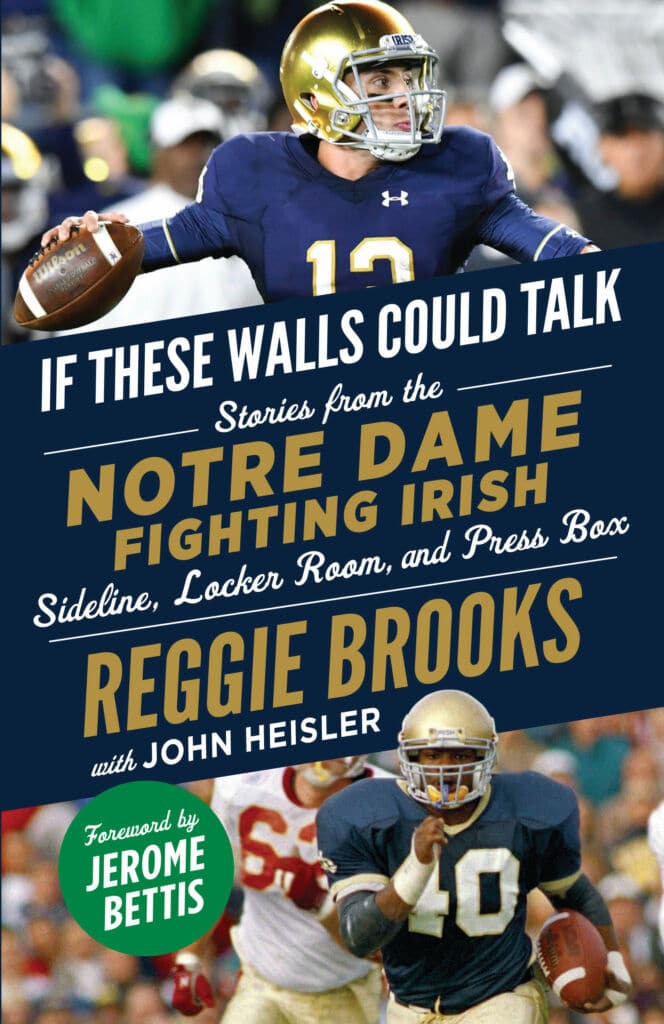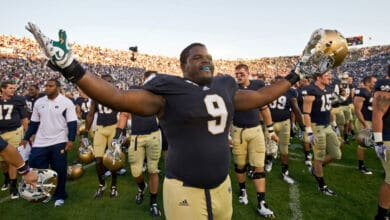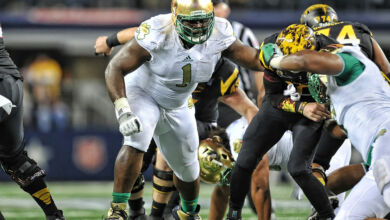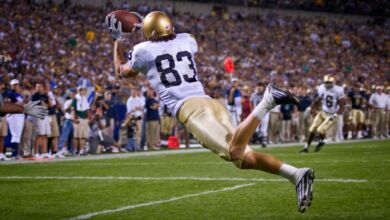
Former Notre Dame great Reggie Brooks released a new book today – “If These Walls Could Talk: Stories From the Notre Dame Fighting Irish Sideline, Locker Room, and Press Box. Triumph Books was kind enough to share an advance copy of Reggie’s new book as well as an excerpt for our readers. In the excerpt below, Reggie talks about his tackle-breaking run against Michigan and his game-winning two-point conversion against Penn State. Plays that Irish fans are still talking about nearly 30 years later.
This excerpt from If These Walls Could Talk: Notre Dame Fighting Irish by Reggie Brooks with John Heisler is reprinted with the permission of Triumph Books. For more information and to order a copy, please visit Amazon, Barnes & Noble, Bookshop.org, or TriumphBooks.com/WallsNotreDame.
CHAPTER 13:
TWO PLAYS TO REMEMBER
The 1992 season marked a better year for me and kind of etched my name in Notre Dame lore and history—specifically based on three games that season and two specific plays.
The first play happened in the Michigan game. It was definitely a bittersweet game. I mentioned before how frustrating that game was because we didn’t maximize the opportunity that we had. We made too many mistakes. Starting fast was something we did a solid job of, but in that game we didn’t finish.
But a lot of people go back to that one play—first-and-10 at the Michigan 20. We were moving the ball—this was still the first quarter— and we ran the option. It’s one of our standard plays, but it really became a play of lore and mystique from that game. It was an out of the ordinary 20-yard run and, as I’ve mentioned before, I did not recall the play after the game. I didn’t really realize what happened until after I saw it Sunday during our film session and team meeting.
It would be considered a read option today, but it was basically a read for Mirer and a fake to Bettis up the middle. It’s an I-formation look, with me as the trailing running back. On the option, you’re always taught to be five-by-five yards from the quarterback. You’re responsible for maintaining the pitch relationship. As the play developed, Mirer did a nice job of pressing the edge and really forcing the end to take him and pitch.
The other thing that always sticks out to me is vision. You have to be able to see what’s coming, not just to avoid it but to know how to attack it. On that particular play, Mirer pitched and I saw Brown—he was the Michigan safety and he was filling the alley. I saw him coming, Mirer made the pitch, and I’m one-on-one. This was something Coach Holtz, Coach Mosley—anyone who played or coached the position as a running back—taught us. You’ve got to make one guy miss. That’s the very least you can do as a running back.
Watching the play, I took the pitch, I saw the alley defender, the receivers were blocking downfield—so that was my guy. It was plain and simple—that was the guy I had to beat. I was known for the spin move and I was off-balance, but I took a shot and maintained my footing.
That came from running through that gauntlet on a daily basis—you have the feel to regain your balance as quickly as possible. I was able to bounce off, fall forward, and I was at about the 7-yard line going in. The defensive back came across from the opposite side and I was stumbling, trying to maintain balance, but going forward I took a shot on the side of the helmet and it was just like, “Bam.” It was at the base of the neck—the bottom of the helmet. Today he probably would have been ejected for targeting, because I was basically defenseless. It was a helmet-to-helmet shot, one that I normally would say I would never forget—but I did.
I got hit around the 4-yard line—it was just momentum and determination to get the ball in the end zone, and at the same time to switch the ball from my left to my right hand was all unconscious muscle memory. You always get the ball to the outside arm roll—get it away from the defender.
I didn’t think anything of it. Okay, you made a play. There was a level of luck there. Had I been three or four yards farther away—had I been around the 10- or even the 8-yard line, that probably would
have been a fumble. It was kind of crazy that I was wrapped around the 4-yard line and was able to get more steps and that my momentum got me into the end zone. Like I said, it was a great play, but at the time it was just a play that you made because that’s what you do. That’s what we did.
Opportunity played a major role in that particular game. We went on to tie that game, but we also made a lot of mistakes and I was part of a botched exchange on a reverse. So you tend to remember not so much the great things but the things you didn’t do quite as well. That game is a tough one to swallow because it had a far-reaching impact on our chase for a national championship. This was senior year, and you fight and scratch and scrap, and you don’t quite get it done—that was the case there.
That play ended up being voted the national play of the year, and they presented Notre Dame with a large framed piece of original artwork showing the play—it hung in the athletic administrative hallway of the Joyce Center for a long time.
* * *
The next play was toward the end of the season. I really feel the Michigan tie affected the decision Coach Holtz made at the end of the game against Penn State. This game was our second-to-last regular-season game, and there was a stretch there where we were playing four ranked teams back-to-back-to-back-to-back. This was also our last home game, so there were a couple of different things that were in play.
The first thing is that the seniors had lost their last home game two years in a row, and that was something that really stuck with us. Secondly, it was against a tough opponent, and it was also a game where we made a lot of mistakes. It was not absolutely horrible, but the footing was not great, partly because of the snow in the middle of the game. It was another game where we had some costly errors that put us in a tough spot, and this time it came down to the very end. Similar to the Michigan game, we were down 6–3 in the first quarter, then tied 6–6 at halftime. We had two extremely good chances to score touchdowns early in the game and came away with field goals. Over those first two quarters we had one drive that lasted almost 10 minutes and wound up with a 26-yard field goal by Hentrich.
We were up 9–6 after three quarters, but Penn State kept battling. Our defense really stepped up—we were really getting on them defensively, just not capitalizing on opportunities. We had snow, we had sleet, and then toward the fourth quarter the sun came out. Every type of weather you can imagine we had at some point during that game. We fought our way back, but we had yet to score a touchdown that entire game. We were a really good football team, but we could not punch the ball into the end zone for three quarters. We did not score a touchdown until the fourth quarter. I still struggle with that. How could that happen? We got down there multiple times, well within the red zone, and still only came away with field goals. That is something that just pains me to think about to this day.
Penn State was up 16–9 in the fourth quarter. We were driving down, and there was just a calmness in the huddle. No panic, no fear of failure—just determination and a complete confidence that we were going to figure this out. We were going to find a way to make this happen.
We drove down the length of the field. We scored, but we actually used our two-point conversion play for the touchdown. It was a fullback pass where Bettis blocked and then leaked out—almost like a little screen to some degree. He came out and scored a touchdown. We were in a position to go for a tie and kick the PAT and the game mostly likely would end in another tie. But I really feel that Michigan game ending in a tie affected our thinking.
Coach Holtz decided to go for two and, again, we’ve already used our two-point conversion that we normally practice. Coach Holtz gave some directions to Mirer, both the basic play call and then some modifications to it. I was surprised I was still in the game—it was known that Coach Holtz didn’t have the utmost confidence in me catching the football.
That was predicated on the fact that I wore contact lenses in the game, but I never wore my contacts in practice because they irritated my eyes. I never thought over the course of that year to practice with my contacts in because I didn’t really like them. I wore glasses to class—I was comfortable wearing glasses. I was not going to wear the goggles—no disrespect to Eric Dickerson. I would just practice without anything, so I really struggled seeing the ball a lot of times in practice. This went on for four years.
I was nearsighted, so things far away were hard for me to pick up. In football one of the things you talk about with catching is that you focus in on the point of the ball or the front half of the ball as it’s coming to you. But, being at a distance, everything was blurry. So I struggled picking up the ball in practice many times. It would get up on me, and it was more of a surprise.
I was really the decoy on the play, just trying to clear it out. I lined up with trips left, a single back who was a single receiver, a tight end on the right. We were basically running multilevel crossing routes, with Bettis trying to create an opening for Irv Smith underneath.
They thought the same thing—thinking they didn’t need to cover him—so I made my way across. I was the inside receiver on the trip side. I tried to pull the linebacker to safety and nobody went with me. As Irv Smith was trying to weave and come back out, the safety and linebacker sat on him and there I was. Mirer was flushed back to the left, he lobbed it up to me—and the rest is history.
Those were two distinct plays—both in that south end zone, southwest corner—that made me a Notre Dame legend in a lot of respects.




